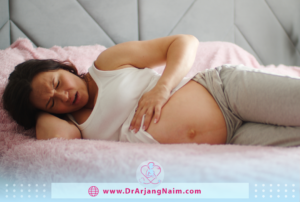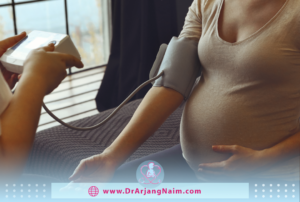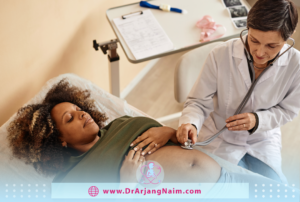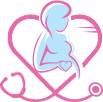Maternal Mortality Ratio is the number of maternal deaths per 100,000 live births. WHO defines maternal death as: “The death of a woman during pregnancy or within 42 days of termination of pregnancy, from any cause related to complications of pregnancy or childbirth. This includes deaths from causes other than direct obstetric complications, such as accidents, preexisting medical conditions, or infections.
When you give birth to your first child, thinking about holding it for the first time and all the beautiful moments you will spend together is exciting. But it can be scary when you don’t know what to expect. Many expectant mothers are worried about childbirth, anesthesia, and complications. It is even natural to think about the possibility of death.
But, if you live in a country like the US, you can breathe easily. In developed countries, death during childbirth or from pregnancy is very rare, even if your pregnancy is high-risk.

Maternal mortality symptoms
There aren’t specific symptoms of maternal mortality itself, as it’s the outcome of complications arising during pregnancy, childbirth, or postpartum (up to 6 weeks after delivery). However, there are warning signs that can indicate a potential complication that could lead to maternal mortality. It’s crucial to seek immediate medical attention if you experience any of these:
- Severe bleeding: Heavy vaginal bleeding that soaks through a pad in an hour or less or passes large blood clots.
- Severe abdominal pain: Persistent or worsening pain in your belly.
- Sudden and severe headache: A headache that won’t go away or worsens over time, especially if accompanied by vision changes or upper right abdominal pain.
- Blurred vision or seeing spots: Changes in your vision can signify preeclampsia or eclampsia.
- Fever: A fever of 100.4°F (38°C) or higher could indicate an infection.
- Difficulty breathing or chest pain: Sudden trouble breathing or chest pain can indicate a blood clot in your lungs.
- Fainting or feeling faint: Feeling lightheaded or dizzy, especially when getting up from lying down.
- Feeling very weak or tired: Excessive fatigue that doesn’t improve with rest.
- Decreased fetal movement: If you’re in the later stages of pregnancy and notice a decrease in your baby’s movement, call your doctor immediately.
- Swelling in your face and hands: Especially if it comes on suddenly.
- Pain or redness in your leg could be a sign of a blood clot.
If you experience these warning signs, call your doctor or midwife immediately or go to the emergency room. Early intervention can help prevent serious complications and save lives.

Reasons
The place of residence has a significant impact on the health and well-being of the pregnant mother. Other factors affect the risks of pregnancy.
Age
Women in their twenties have fewer complications during pregnancy than younger or older women. Young girls under the age of 15 have a higher chance of developing complications that can lead to death. Risks also increase with maternal age and increase when women become pregnant in their late 30s or their 40s and 50s.
Social and economic status
Poor women in a low socioeconomic group may have less education, poor diet, and barriers to health care. Nutritional deficiencies can lead to health deficiencies and poor pregnancy outcomes. Failure to receive quality care puts women at risk for infection or other complications that could otherwise be managed and treated by a skilled healthcare provider.
Gender inequality
In some countries, girls and women have fewer education opportunities. They are often deprived of financial resources and have no say in their lives and family choices.
Resources available
For many women, medical care is out of reach and difficult to access. Lack of prenatal care, delivery without the presence of skilled personnel such as a doctor, midwife, or nurse, and lack of access to treatments such as antibiotics and emergency services can have life-threatening consequences.
Parity
Parity is the number of times a woman has been pregnant. The probability of problems in pregnancy or problems during childbirth is slightly higher in the first pregnancy. Chances are lower in the second pregnancy. But, after five or more pregnancies, the risk increases once again.
Causes
In the United States, severe pregnancy complications and maternal death are rare. With proper medical care, most of the problems that arise during pregnancy, childbirth, and the postpartum period can be treated or even prevented.
However, the situation is more dangerous in other parts of the world. Here are the main causes of maternal mortality.
Postpartum bleeding
Postpartum hemorrhage (PPH) is excessive bleeding and blood loss after childbirth. A skilled doctor can usually stop the bleeding. But, if a healthcare provider with the right knowledge and skills is not available, the mother can die from excessive blood loss.
Postpartum hemorrhage is responsible for approximately 27% of maternal deaths.

High blood pressure and eclampsia
Prenatal care and tests usually identify problems such as high blood pressure and protein in the urine. With good medical care, doctors can treat and control preeclampsia. But, without care, it can become dangerous and lead to death. Blood pressure disorders are responsible for 13.3% to 15.9% of pregnancy-related deaths.
Infection
Women may become infected as a result of unsafe abortions, unhygienic births, or very long labor. Lack of understanding and information about personal hygiene and how to take care of the body after childbirth can also put the mother at risk of infection. About 11% of maternal deaths are the result of infection.
Pulmonary embolism
A pulmonary embolism (PE) is a blood clot in the lungs. PE can develop after delivery, and the risk is higher with a cesarean section. About 9.2% of maternal deaths are caused by pulmonary embolism.
Other direct effects
Approximately 10 percent of women die from other complications directly related to pregnancy. Conditions such as placenta previa, uterine rupture, and ectopic pregnancy without proper care and treatment can lead to complications and death.
Other indirect causes
Indirect cause of death in pregnant women is caused by conditions that are not directly related to pregnancy but develop or worsen during pregnancy. Pregnancy can affect health problems such as HIV and heart disease. Conditions such as diabetes and anemia may develop or worsen. These issues account for approximately 28% of maternal deaths.

Making pregnancy safer
Many steps can be taken to make pregnancy safer for both mother and baby.
Preconception and prenatal care
- Preconception health: Addressing preexisting health conditions like diabetes or high blood pressure before pregnancy can significantly reduce risks.
- Regular prenatal care allows for early detection and management of potential problems. It includes regular checkups with a doctor or midwife, screenings, and prenatal vitamins.
- Education and awareness: Empowering women with knowledge about pregnancy, potential risks, and healthy habits can lead to better decision-making.
- Family planning: Access to contraception and family planning services allows women to plan for pregnancy when they are ready, physically and emotionally.
Strengthening healthcare systems
- Skilled birth attendants: Ensuring deliveries are attended by qualified healthcare professionals trained in emergency obstetric care can significantly reduce complications.
- Improved facilities: Access to well-equipped healthcare facilities with essential medications and equipment is crucial for handling emergencies.
- Emergency care systems: Reliable transportation and functioning emergency response systems allow for quick access to higher levels of care if needed.
Social and economic factors
- Reduced poverty and inequality: Poverty and lack of access to education and healthcare disproportionately impact maternal mortality rates.
- Improved nutrition: Proper nutrition before, during, and after pregnancy is essential for the health of the mother and baby.
- Empowerment of women: Improving women’s social and economic status allows them greater control over their health decisions.
- Community involvement: Educating communities about pregnancy dangers and promoting supportive environments for pregnant women can contribute to better outcomes.
Technological advancements
- Telehealth and mobile health: These technologies can improve access to healthcare, especially in remote areas, by providing remote consultations and information.
- Innovation in diagnostics and monitoring: Developing new tools for early detection of complications can allow for timely interventions.
The bottom line
In the past, pregnancy and childbirth were more dangerous. But nowadays, it is much safer to have children. If you receive regular prenatal care, eat well, make good lifestyle choices, and have a skilled doctor during your delivery, your chances of having a healthy pregnancy and delivery are excellent.
Dr. Arjang Naim is one of the best obstetricians and gynecologists in pregnancy and childbirth.
Additional questions
- What are the main causes of bleeding during pregnancy?
- Implantation bleeding
- Cervical changes
- Miscarriage or ectopic pregnancy
- What is a normal fetal movement?
Fetal movement varies throughout pregnancy. In the first trimester, you likely won’t feel anything. During the second trimester, it starts as fluttering and becomes more frequent. By the third trimester, you’ll feel kicks, jabs, rolls, and stretches. Movement may slow down near the end, but you should still feel it regularly.
- How do you reduce blood pressure during pregnancy?
Staying active and engaging in daily physical activity like walking or swimming can help keep blood pressure within a normal range. Eating a balanced diet and consuming low salt can also help lower blood pressure.
- What are the three stages of postpartum bleeding?
Step 1: Lucia Rubera. Duration: 3-4 days after delivery.
Step 2: Lucia Serosa. Duration: 4-10 days after delivery.
Step 3: Lucia Alba. Duration: 10-28 days after delivery.
- What are the 5 cases of maternal mortality?
The five most important direct causes of maternal mortality in developing countries are hemorrhage, sepsis, unsafe abortion, eclampsia, and obstructed labor.
References
https://ourworldindata.org/maternal-mortality
https://www.who.int/news-room/fact-sheets/detail/maternal-mortality
https://www.verywellfamily.com/maternal-mortality-rate-causes-and-prevention-4163653




